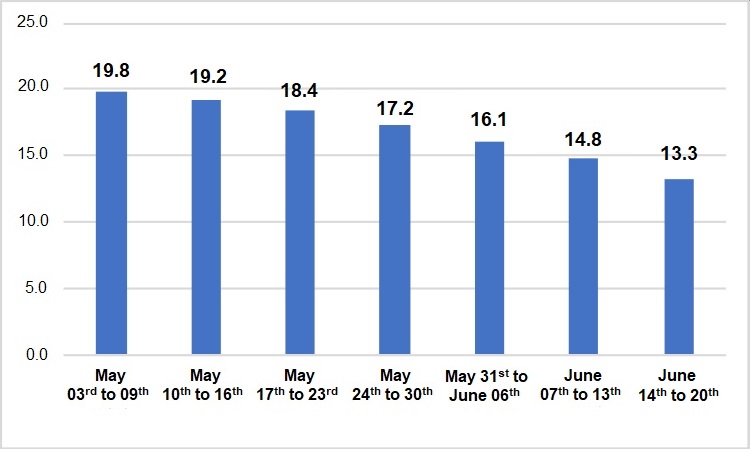PNAD COVID19: 13.3% of employed population was away from work due to social distancing between June 14-20
July 10, 2020 09h00 AM | Last Updated: July 13, 2020 11h31 AM
This proportion dropped in relation to the previous week (14.8%) and against the first week of the survey, from May 3 to 9 (19.8%).
PNAD COVID19 estimated at 84.0 million the employed population in Brazil in the week of June 14-20, remaining stable in relation to the previous week (83.5 million persons) and in relation to the week of May 3-9 (83.9 million persons). Among them, 8.7 million (or 12.5% of the employed persons) worked remotely, a contingent that remained statistically stable in relation to the previous week (8.5 million or 12.5%) and also in relation to the week of May 3-9 (8.6 million or 13.4%).
The employment-population ratio was 49.3%, remaining stable against the previous week (49%) and in relation to the week of May 3-9 (49.4%).
The proxy of the informality rate fell to 33.9%, both in relation to the previous week (35%) and in relation to the week of May 3-9 (35.7%).
Nearly 11.1 million (13.3% of the employed population) were away from work due to social distancing. This contingent reduced in relation to the previous week (12.4 million or 14.8% of the employed population) and also in relation to the week of May 3-9 (16.6 million or 19.8% of those employed).
Percentage of employed persons away from work due to social distancing in relation to the total employed population in the reference week - Brazil (%)

The unemployed population was estimated at 11.8 million persons and remained statistically stable in relation to the previous week (11.9 million), though it grew in relation to the week of May 3-9 (9.8 million). As a result, the unemployment rate stayed at 12.3% for the period between June 14 and 20, which pointed out to a stability in relation to the previous week (12.4%) and a rise against the first week of May (10.5%).
The workforce participation rate stayed at 56.2% between June 14 and 20, which pointed out to a stability in relation to the previous week (56%), but to an increase in the comparison with the first week of May (55.2%).
The population out of the workforce – that was neither working nor looking for a job – was of 74.5 million persons, a statistical stability in relation to the previous week (74.9 million) and a drop in relation to the week of May 3-9 (76.2 million). In this population, nearly 26.4 million persons (or 35.4% of the population out of the workforce) stated that they would like to work. This contingent remained stable in relation to the previous week (26.7 million or 35.7%) and against the week of May 3-9 (27.1 million or 35.5%).
Nearly 17.3 million persons out of the workforce who would like to work and did not look for a job, did not do it because of the pandemic or because they could not find a job in the locality where they lived. They corresponded to 65.8% of the unemployed persons who did not look for a job and would like to work. This contingent decreased in relation to the previous week (18.2 million or 68.0%) and compared with the week of May 3-9 (19.1 million or 70.7%).
3.1 million persons with symptoms of flu syndrome looked for health establishments
In the week from June 14 to 20, PNAD COVID19 estimated that 15.3 million persons (or 7.2% of the Brazilian population) showed at least one of the 12 symptoms associated to the flu syndrome (fever, cough, sore throat, difficulty to breathe, headache, chest pain, nausea, stuffy or runny nose, fatigue, eye pain, loss of smell or taste and muscle pain) which are investigated by the survey. This contingent remained stable against the previous week (15.6 million or 7.4% of the population) and dropped in relation to the week of May 3-9 (26.8 million or 12.7%).
Nearly 3.1 million persons (or 20.1% of those who showed any symptom) looked for a health establishment to be assisted (health centers, family health teams, UPAs, SUS medical centers or hospitals or even private ambulatories/offices, medical centers or hospitals). This contingent remained stable in relation to the previous week (3.0 million or 19.2%), though it dropped in absolute numbers against the week of May 3-9 (3.7 million or 13.7%). More than 85% of this assistance were in the public health network.
Between June 14 and 20, 440 thousand persons (14.3%) who had symptoms of flu syndrome looked for assistance in private or military ambulatories or offices. This proportion represented an increase both in the comparison with the previous week (271 thousand or 9.1%) and in relation to the first week of May (320 thousand or 8.7%).
Nearly 976 thousand persons looked for assistance either in public, private or military hospitals in the week between June 14 and 20. This contingent remained statistically stable in relation to the previous week (900 thousand) and also against the week of May 3-9 (1.1 million). Among those who looked for assistance, 110 thousand (11.3%) were hospitalized. It also remained stable against the previous week (110 thousand or 12.2%) and in relation to the week of May 3-9 (97 thousand or 9.1%).

